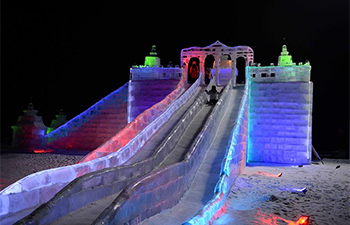by Xinhua writer Guo Ying
BEIJING, Jan. 31 (Xinhua) -- It's hard for ordinary people to relate chemical reactions with beauty, but a Chinese man with a background in chemistry is trying to offer a new perspective with videos featuring these reactions on microscopic level.
Showing vivid details that resemble fast-growing trees, blossoming flowers and even a dancing elf in the night sky, the videos unveil the glory and visual poetry of chemistry.
These videos are part of a program called "Envisioning Chemistry," which includes 15 films with a total length of 25 minutes. The videos offer close-up views of chemical reactions such as precipitation, crystal growth, metal displacement, and combustion, and are accompanied by instrumental music that adds artistic feel.
According to the creator Liang Yan, the team uses professional photography equipment such as high-resolution microscope and high-speed and thermal imaging cameras to capture the process of chemical reactions.
"We experimented with a large scope of chemical reactions and explored their artistic side. New ideas and inspirations always emerged after we started the experiments. Some ideas did not work while other reactions created beauty beyond our imagination," Liang said.
Envisioning Chemistry tries to capture a purely objective record of chemical reactions.
"We did not add any special effects or change the colors to make it more beautiful, as we hope to hold true to the chemistry reaction," Liang said.
Most chemical experiments happen in glassware such as test tubes and beakers, however, the reflection and refraction of glassware makes it difficult to film what's actually going on inside.
To make the glassware invisible, Liang uses a cuvette, a device made of optical glass, as the container, which greatly reduced the distraction of the glassware in the filming process.
According to Liang, "Getting Hot (with Thermal Imaging)" was the most challenging film to make. Using a thermal imaging camera, they hoped to visualize temperature changes in the chemical reaction.
"For each reaction, we shot both the normal visible light footage and infrared thermal imaging footage. We cannot see much in the visible light but can see a lot more in the thermal imaging, and the comparison makes the film more interesting," Liang said.
Liang has been fascinated by all kinds of chemistry experiments since junior high school and majored in chemistry in Tsinghua University. In his spare time, he developed an interest in computer graphics and even published a book on Photoshop with his classmates.
While studying in the United States, he was greatly inspired by Janet Iwasa, a biologist and animator who explores the intersection between science and visualization. He thought he could combine his background in chemistry and his hobby of computer graphics to start a career path in scientific visualization.
"Scientific visualization is a very broad concept, which is used in many fields such as medicine, physics and astronomy. The basic idea is to visualize scientific data or processes that are invisible to the naked eyes," Liang said.
After obtaining a doctorate degree in materials science from the University of Minnesota in 2011, he worked for Digizyme, a company that create visual context for understanding science. He also did freelance illustration work for researchers all over the world.
After returning to China, he led a small team from University of Science and Technology of China and Tsinghua University Press that created the "Beautiful Chemistry" project in 2014, which earned wide acclaim and gave Liang the confidence to focus on the area.
In order to bring the beauty and wonder of chemistry to a wider audience, Liang started Envisioning Chemistry in 2017 and invited Zhu Wenting, a visual communication major, to join the team to help adopt a more artistic approach in filming.
The videos have gone viral on some social network platforms, receiving comments such as "If I had seen these videos in high school, I might have done much better in chemistry."
The videos have also received feedback from educators all over the world. Many shared their experience of using these videos to engage students in the classroom.
"You have brought together visualization at a level of detail that does get my students excited. The oohs and aaahs from the students when watching the electrodeposition (video) is, in a word, awesome," wrote an American high school teacher.
These comments prompted Liang to think more about education and the project's potential in helping science education.
"Many Chinese students consider chemistry as a boring and abstract subject as they have to memorize a lot of elements and equations. I hope these videos can arouse their interest and curiosity in chemistry from a young age," Liang said.
Liang has moved beyond chemistry and set up the Beauty of Science brand, providing inspiring science education products and services for schools and families to encourage the curiosity of children and expose them to the beauty of science.
China attaches great importance to science education to nurture talent. From September 2017, primary schools in China have provided science courses from first grade.
Liang believes that rote learning is not suitable for such young children and teachers should go beyond the textbooks to get the children involved in science.
"I hope to do my bit in making science education more interesting and inspirational," Liang said.

















